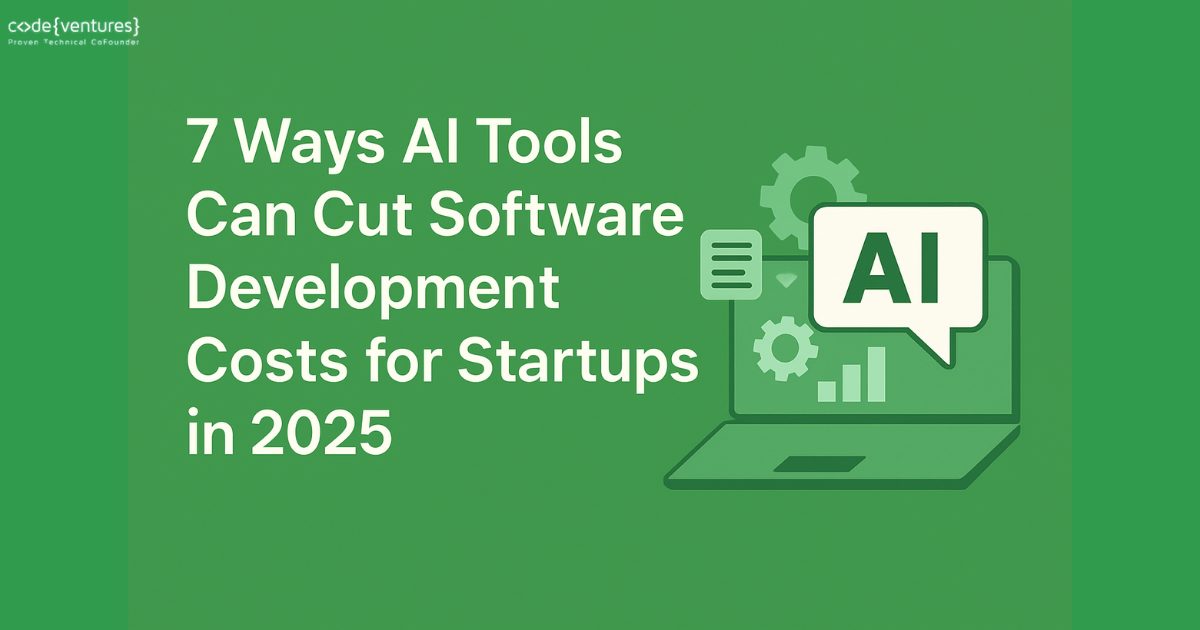7 Ways AI Tools Can Cut Software Development Costs for Startups in 2025

Building a software product is never cheap, especially for startups. With limited funding, lean teams, and the pressure to get an MVP out fast, every dollar spent needs to deliver results. Between hiring engineers, designing intuitive UIs, integrating APIs, and maintaining infrastructure, costs can spiral quickly.
Fortunately, in 2025, AI has become a powerful ally. AI generated business plans have come into action. AI tools that can dramatically reduce software development costs without sacrificing product quality, usability, or speed.
In this guide, we’ll explore why software product development for startups is expensive and break down seven practical ways AI can help you save money, move faster, and build smarter.
Why Software Development Is So Expensive for Startups
Early-stage development is one of the most financially draining phases of building a startup. Here’s why:
1. Talent is Costly
Hiring skilled developers for your startup can cost upwards of $80,000–$150,000/year per engineer. Even outsourcing to agencies isn’t always cheap, and it introduces delays and communication friction.
2. Everything Starts from Scratch
From designing wireframes to setting up backend logic and writing documentation, you’re not just building a product, you’re building systems, pipelines, and processes.
3. Frequent Iteration Is the Norm
Startups need to launch fast and iterate often based on user feedback. This agility, while crucial, results in rewrites, pivoted features, and additional dev hours.
4. Complexity Scales Fast
Third-party integrations, analytics tools, performance optimization, testing frameworks—it all adds up, especially if done manually.
7 Ways to Use AI Tools to Cut Software Development Costs

Let’s dive into how AI tools can reduce expenses across every stage of software development.
1. Generate Code with AI Coding Assistants
Tools: GitHub Copilot, Amazon CodeWhisperer, ChatGPT, Tabnine
These AI assistants help developers write cleaner, faster code by:
- Auto-completing code as you type
- Generating boilerplate code (e.g., API handlers, DB models)
- Refactoring or debugging legacy code
- Writing unit tests and documentation
Cost savings: Reduces reliance on junior developers or agencies
Speed gains: Accelerates development by 2x–4x during prototyping
Tip: Pair AI coding tools with a strong code review process to ensure quality.
2. Use AI for Rapid Prototyping and MVPs
Tools: Replit AI, Glide, Softr, Builder.io, Bubble
AI-enhanced no-code/low-code platforms allow non-technical founders to:
- Build basic web/mobile apps visually
- Generate working backends from a schema or spreadsheet
- Create internal dashboards with minimal code
Cost savings: Avoids custom builds for early versions or internal tools
Bonus: Build successful MVPs without a whole dev team.
Example: A founder creates a client portal in Glide from Google Sheets in 3 days instead of hiring a developer for 3 weeks.
3. Accelerate UI/UX Design with AI
Tools: Uizard, Figma AI, Framer AI
These tools help designers and product teams:
- Convert hand-drawn sketches or prompts into clickable prototypes
- Auto-generate layout suggestions
- Create responsive components in seconds
Cost savings: Cuts design timelines by 50–70%
Bonus: Focus designers on UX strategy, not repetitive layout tasks
Tip: AI won’t replace creative UX work, but it can handle tedious design chores quickly and accurately.
4. Automate Testing and QA
Tools: Testim, Autify, Mabl, Virtuoso
QA is often overlooked early on, but bugs are expensive. AI-powered testing tools can:
- Automatically generate test cases from user flows or stories
- Detect visual regressions across browsers and devices
- Suggest bug fixes and refactor test cases when needed
Cost savings: Reduces or delays the need for a dedicated QA team
Bonus: Improves code quality and customer experience
Best practice: Combine AI test automation with manual exploratory testing for best results.
5. Simplify Documentation and DevOps
Tools: ChatGPT, CodiumAI, Pulumi with AI, GitHub Copilot (for CI/CD)
These tools can automate:
- Technical documentation generation
- Infrastructure-as-code scripts for AWS, Azure, etc.
- CI/CD pipelines and deployment configurations
Cost savings: Avoid hiring technical writers or DevOps engineers early
Bonus: Accelerates team onboarding and infrastructure scaling
Example: Instead of manually writing deployment YAMLs, use Copilot to scaffold GitHub Actions in minutes. Explore practical project management tools that complement these processes.
6. Leverage AI for Customer Support & Onboarding
Tools: Intercom Fin, ChatGPT API, Zendesk AI, Freshdesk Freddy
With AI chatbots and guided onboarding:
- Support tickets are resolved instantly using knowledge base-trained bots
- Users receive real-time in-app tutorials and onboarding flows
- FAQs, error resolution, and walk-throughs are handled autonomously
Cost savings: Delay building a whole support team
Bonus: Improve user satisfaction with 24/7 instant responses
Pro Tip: Fine-tune your AI support bots using your docs and customer conversations for better accuracy.
7. Replace Expensive Features with AI APIs
Instead of reinventing the wheel, startups can plug in powerful AI APIs:
| Use Case | AI Tool/Service |
| Summarizing Text | OpenAI GPT-4, Cohere |
| Image/Video Generation | Stability AI, RunwayML |
| Speech-to-Text | Whisper, AssemblyAI |
| Chatbots | OpenAI, Anthropic, HuggingFace |
Cost savings: Skip months of R&D on NLP, vision, or voice models
Bonus: Deliver advanced features with fewer resources
Use case example: Add voice memo transcription to your app using AssemblyAI in hours, versus building custom models in months.
Real-World Example: MVP Built with an AI-First Stack
A solo SaaS founder wants to build a tool that summarizes sales calls.
Traditional Path (Without AI):
- Full-stack dev (3 months): $30,000
- NLP experts for custom summaries: $15,000+
- QA and deployment: $5,000+
- Total: $50,000+
AI-Enhanced Path:
- Framer AI + Supabase for frontend/backend: 2 weeks
- AssemblyAI for call transcription
- GPT-4 for summary generation
- Total: ~$5,000 and under 1 month
The result? A working MVP that’s good enough to validate the market and onboard early users, without burning half the startup’s budget.
Final Thoughts: Build Smarter, Not Just Cheaper
AI tools won’t replace your need for solid product strategy, engineering fundamentals, or user research. But they can extend your capabilities, compress timelines, and reduce costs dramatically.
If you’re building a startup in 2025, think of AI not as a shortcut, but as a multiplier. Use it to:
- Launch MVPs faster.
- Iterate based on feedback.
- Stretch your funding runway.
- Focus your team on creativity and impact.
In a competitive landscape, startups that embed AI thoughtfully into their operations will gain a decisive edge. However, building and maintaining these systems requires a combination of vision, technical depth, and strategic execution.
This is where Codeventures can help. Whether you need support validating your product idea, crafting your AI roadmap, or building scalable solutions, Codeventures acts as a hands-on technical co-founder. Team provides tailored startup resources, strategic startup guidance, and end-to-end development expertise to help early-stage ventures bring AI-driven products to market faster and smarter.

Let’s Build Your Next Project Together
Take your startup to the next level with our expert guidance and technical solutions. Partner with us and unlock new opportunities for success!
Contact Us